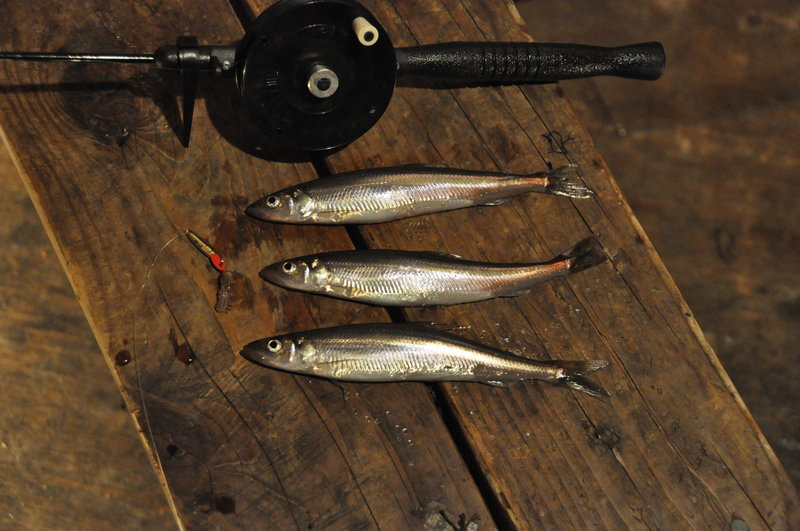Despite the midwinter warm-up this past week, ice conditions throughout much of the state are very good, and smelt shacks are popping up on the state’s tidal rivers.
I am sure you recognize the shacks as you cruise up the Kennebec River corridor. For me, they are a sign that winter truly has arrived, as it takes a prolonged cold snap to secure the ice on these tidal rivers.
The shacks are placed on the ice along eddies, oxbows, underwater structures and just about anywhere that looks “fishy.” Some ice fishers return to the same spot each year, others will explore until they find the right spot. All of them are in search of rainbow smelt.
Smelt are an anadramous fish that returns to Maine’s tidal rivers in the winter as it prepares to spawn.
This fish, which generally ranges in size from 7 to 9 inches, is prized for its sweet, white flesh. Smelts are the target of many anglers, not only from Maine but from throughout New England.
Smelt were once abundant throughout New England, and their range extended south all the way to the Chesapeake Bay.
Currently, however, Maine is the New England stronghold for smelt, with few, if any smelt returning to rivers in Massachusetts and Connecticut.
Fortunately for those who don’t want to risk life or limb dragging an ice shack across a shell of ice, there are several commercial camp operations that operate in the Kennebec River watershed each winter. For less than the price of a lift ticket or a round of golf, you can rent a shack for a full tide and try your hand at catching smelts.
You can find a list of these smelt camps on the Maine Department of Marine Resources website at www.maine.giv/dmr/recreational/smeltcamps/.
Anglers fish for smelt in a variety of ways. You can use house lines, which generally are hanging from the ceiling of the shack. Many will bring small jigging rods, which have extremely sensitive tips or a spring bobber tip that can detect subtle strikes.
Bait your hook with a small piece of sandworm, generally about the length of your fingernail. If you are using a jigging rod, use a small lure as well with a piece of worm. A small Swedish Pimple, size 2, is my preference.
More serious smelt anglers will use multiple jigging rods, or even what is called a spring board, a homemade contraption that has several reels and jigging tips fastened to a board. Used with a baited hook, the spring tip bobs up and down, alerting anglers to a strike.
Adventurous smelt anglers use sabiki jig rigs, which are designed for saltwater fish like mackerel. Generally, there are seven laser-sharp dressed hooks attached to the line, and while they are quite effective for catching fish, they are even more adept at getting tangled and piercing unsuspecting fingers.
If you want to use these, I suggest dividing one rig into several, using no more than two sabiki hooks to a line. Catch two smelts at once on that rig, and you will be happy you only have to untangle two hooks.
Smelt are not strong swimmers, and they cruise the river with the flow of the tides. Experienced fishermen know that smelting can be hit or miss. On some tides, anglers can fill a bucket with smelt, and then the following tide they can get skunked. One of the more familiar refrains smelt fishers will hear from camp operators is “you shoulda been here last night.”
Of course, smelt fishing is at the whim of the weather, so don’t delay. Last year’s late winter start and early spring limited some camp operators to just three weeks on the ice, so make your reservations now before that next warm front arrives and the smelt shacks disappear from the ice even quicker than they arrived.
Mark Latti is a Registered Maine Guide, and the Landowner Relations/ Recreational Access Coordinator for the Department of Inland Fisheries and Wildlife.
Send questions/comments to the editors.



Success. Please wait for the page to reload. If the page does not reload within 5 seconds, please refresh the page.
Enter your email and password to access comments.
Hi, to comment on stories you must . This profile is in addition to your subscription and website login.
Already have a commenting profile? .
Invalid username/password.
Please check your email to confirm and complete your registration.
Only subscribers are eligible to post comments. Please subscribe or login first for digital access. Here’s why.
Use the form below to reset your password. When you've submitted your account email, we will send an email with a reset code.